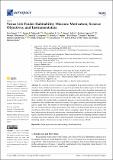Venus Life Finder Habitability Mission: Motivation, Science Objectives, and Instrumentation
Author(s)
Seager, Sara; Petkowski, Janusz J.; Carr, Christopher E.; Saikia, Sarag J.; Agrawal, Rachana; Buchanan, Weston P.; Grinspoon, David H.; Weber, Monika U.; Klupar, Pete; Worden, Simon P.; Iakubivskyi, Iaroslav; Pajusalu, Mihkel; Kaasik, Laila; on behalf of the Venus Life Finder Mission Team,; ... Show more Show less
Downloadaerospace-09-00733.pdf (2.002Mb)
Publisher with Creative Commons License
Publisher with Creative Commons License
Creative Commons Attribution
Terms of use
Metadata
Show full item recordAbstract
For over half a century, scientists have contemplated the potential existence of life within the clouds of Venus. Unknown chemistry leaves open the possibility that certain regions of the Venusian atmosphere are habitable. In situ atmospheric measurements with a suite of modern instruments can determine whether the cloud decks possess the characteristics needed to support life as we know it. The key habitability factors are cloud particle droplet acidity and cloud-layer water content. We envision an instrument suite to measure not only the acidity and water content of the droplets (and their variability) but additionally to confirm the presence of metals and other non-volatile elements required for life’s metabolism, verify the existence of organic material, and search for biosignature gases as signs of life. We present an astrobiology-focused mission, science goals, and instruments that can be used on both a large atmospheric probe with a parachute lasting about one hour in the cloud layers (40 to 60 km) or a fixed-altitude balloon operating at about 52 km above the surface. The latter relies on four deployable mini probes to measure habitability conditions in the lower cloud region. The mission doubles as a preparation for sample return by determining whether a subset of cloud particles is non-liquid as well as characterizing the heterogeneity of the cloud particles, thereby informing sample collection and storage methods for a return journey to Earth.
Date issued
2022-11-21Department
Massachusetts Institute of Technology. Department of Earth, Atmospheric, and Planetary Sciences; Massachusetts Institute of Technology. Department of Physics; Massachusetts Institute of Technology. Department of Aeronautics and AstronauticsPublisher
Multidisciplinary Digital Publishing Institute
Citation
Aerospace 9 (11): 733 (2022)
Version: Final published version